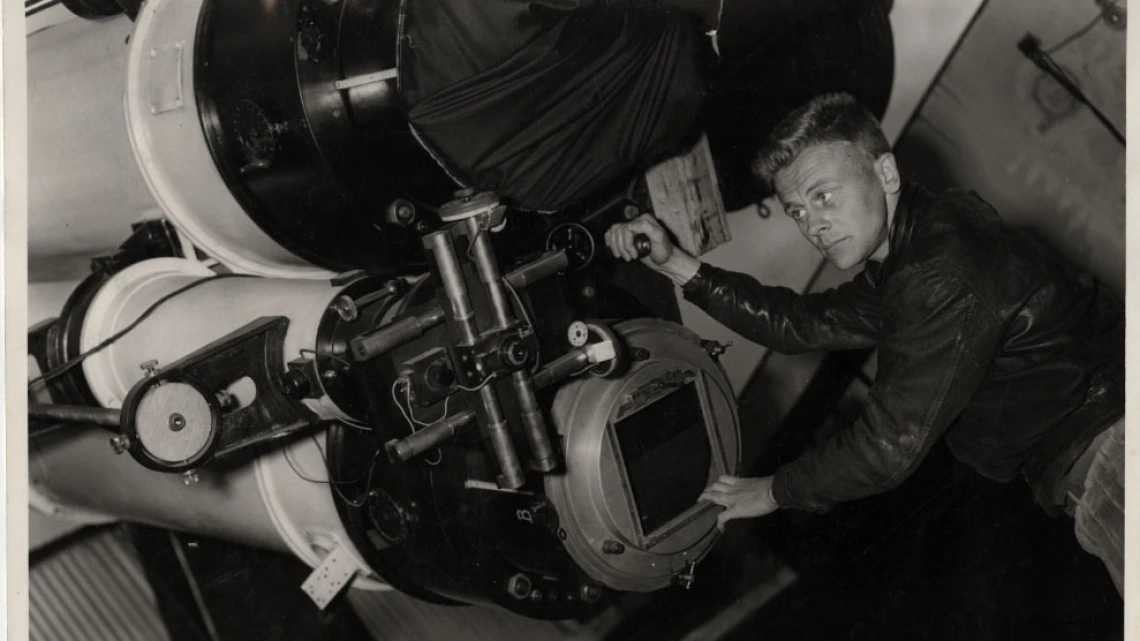Tom Gehrels papers

Photograph of astronomer Tom Gehrels at telescope, circa 1955.
Collection area: History of Science
Collection dates: 1894-2011 bulk (bulk 1960-2000)
Papers 1894-2010 (bulk 1960-2000). This collection consists of the professional and some personal papers of Tom Gerhels. The bulk of the material consists of his correspondence with other astronomers, scientists, state and federal politicians. There are also scholarly files, research files, and personal interest files. Almost all amassed during his fifty year career at the Lunar Planetary Laboratory and the Department of Planetary Sciences, University of Arizona. Other items in the collection are environmental files, travel files, instructional files, newspaper clippings, photographs, slides, film, computer disks and CDs.
Tom Gehrels was born Anton M. J. Gehrels in Haarlemmermeer, the Netherlands on February 21, 1925. As a teenager, after Nazi Germany invaded the Netherlands in 1939, Gehrels became active in the Dutch Resistance. He later escaped to England where he received further training and was sent back by parachute to his native country as an organizer for Britain’s Special Operations Executive (SOE) which committed sabotage and spied on the German forces.
After the war Gehrels attended the University of Leiden where he graduated with a degree in physics and astronomy in 1951. He continued his education at the University of Chicago where he obtained his doctorate in astronomy and astrophysics in 1956. Dr. Gehrels was a research associate at Indiana University and McDonald Observatory for five years where he pioneered the first photometric system for asteroids.
In 1961 he joined Dr. Gerard Kuiper at the University of Arizona where he was one of the first members of the Lunar and Planetary Laboratory and a faculty member of the Department of Planetary Sciences and Astronomy. Gehrels remained at the University for the next 50 years until his death in 2011.
While at the University of Arizona Dr. Gehrels developed a program of photolarimetry. His studies led to the discovery and interpretation of wavelength dependence on the polarization of light from a variety of objects. He was the principle investigator for the team that created the imaging photo-polarimeters for Pioneers 10 and 11 and the 1st flybys of Jupiter and Saturn in the 1970s.
He participated in the discovery of over 4000 asteroids. This was done in a sky survey using the 48-inch Schmidt telescope at Palomar Observatory in California and shipping the plates to two Dutch astronomers at Leiden Observatory, in the Netherlands who analyzed them for new asteroids. Gehrels also discovered a number of comets
Dr. Gerhels also developed and taught introductory astronomy courses that were popular with non-science undergraduates. Besides teaching at the University of Arizona he also lectured at the Physical Researh Laboratory in Ahmedabad (India), where he was a Lifetime Fellow.
In 1980 Dr. Gehrels started the Spacewatch Project (a program to find dangerous asteroids and to keep them from hitting the earth), this program still uses the telescopes at Steward Observatory and Kitt Peak to survey the sky for asteroids and comets. He was also the founder of the highly recommended Space Science Series which was published by the University of Arizona Press. Gehrels was the editor for the first 30 volumes of the series.
Dr. Gehrels was a part of the Dutch resistance during World War II and his brother died at the Dora concentration camp, where the VI and V2 rockets were built toward the end of the war. In 1994 he was asked by the journal
In the latter part of his career Dr. Gehrels focused on the research of cosmology and universal evolution. He published an original paper on the subject titled "The Multiverse and Origin of our Universe"
In 2007, the American Astronomical Society's Division for Planetary Sciences presented Gehrels with the Harold Masursky Award for meritorious service to planetary science. In April 2011, Gehrels was honored for his 50 years of service at the annual University of Arizona Service Awards luncheon.
Dr. Gehrels was the husband of Aleida J. Gehrels (née de Stoppelaar) and father of Neil Gehrels, George Gehrels and Jo-Ann Gehrels. He died in Tucson, Arizona on July 11, 2009 at age 86. He was devoted to yoga and hiking as well as an active member of Greenpeace and the Humane Farming Association (HFA).
Dr. Gehrels’s interests included environmental, political, and humanitarian issues.
A collection guide explains what's in a collection. New to using our collections? Learn how to use a collection guide.
Collection guideThe collection has materials you can access online.
Access this collection
Visit us in person to access materials from this collection. Our materials are one-of-a-kind and require special care, so they can’t be checked out or taken home.
How to cite
Learn how to cite and use materials from Special Collections in your research.
